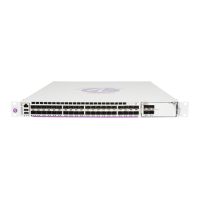VPRN Features
Page 420 7705 SAR OS Services Guide
IPCP
Similar to DHCP over Ethernet interfaces, Internet Protocol Control Protocol (IPCP)
extensions to push IP information over PPP/MLPPP VPRN (and IES) SAPs are supported.
Within this protocol, extensions can be configured to define the remote IP address and DNS
IP address to be signaled via IPCP on the associated PPP interface. The IPCP-based IP and
DNS assignment process is similar to DHCP behavior; IPCP-based IP/DNS assignment is a
natural use of PPP/MLPPP IP layer protocol handshake procedures. PPP/MLPPP connected
devices hooked up to VPRN (and IES) can benefit from this feature for the assignment of IP
and DNS to the associated interface.
Troubleshooting and Fault Detection Services
Bidirectional forwarding detection (BFD) can be configured on the VPRN interface. BFD is
a simple protocol for detecting failures in a network. BFD uses a “hello” mechanism that
sends control messages periodically to the far end and expects to receive periodic control
messages from the far end. On the 7705 SAR, BFD is implemented for static routes in
asynchronous mode only, meaning that neither end responds to control messages; rather, the
messages are sent periodically from each end.
To support redundancy with fast switchover, BFD must be enabled to trigger the handoff to
the other route in case of failure.
Due to the lightweight nature of BFD, it can detect failures faster than other detection
protocols, making it ideal for use in applications such as mobile transport.
If BFD packets are not received in the configured amount of time, the associated static route
is declared “not active”, causing a reroute to an alternative path, if any.
The 7705 SAR also supports Internet Control Message Protocol (ICMP). ICMP is a message
control and error reporting protocol that also provides information relevant to IP packet
processing.
Note: Link failures detected by BFD will disable the IP interface.

